CBSE Class 5 Worksheet for EVS Chapter Matter and Materials Questions with Answers
Section – I
Q.1 A substance that occupies space and has mass is called:
(A) Air
(B) Matter
(C) Soil
(D) Water
Answer
(B)Q.2 Which among the following is not a name of one of the states of matter?
(A) Solid
(B) Liquid
(C) Glass
(D) Gas
Answer
(C)Q.3 Replace the numbers in the given figure -by correct terms.
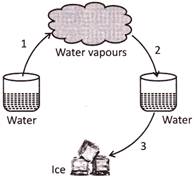
(A) 1 - Condensation, 2 - Freezing, 3 ? Evaporation
(B) 1 - Evaporation, 2 - Condensation, 3 ? Freezing
(C) 1 - Freezing, 2 - Evaporation, 3 ? Condensation
(D) 1 - Evaporation, 2 - Freezing, 3 ? Condensation
Answer
(B)Q.4 Match the following:
| Column A | Column B |
| i. Ice cream | A. Liquid |
| ii. Water vapour | B. Solid |
| iii. Melted ice cream | C. Gas |
(A) (i - C), (ii - A), (iii - B)
(B) (i - B), (ii - A), (iii - C)
(C) (i - B), (ii - C), (iii - A)
(D) (i - A), (ii - C), (iii - B)
Answer:
(C)Q.5 To loosen a lid of ajar we keep it in hot water because:
(A) Hot water tighten the lid.
(B) Warm water enters into the jar.
(C) Heating can expand the lid and it open out easily.
(D) Heating contracts the lid of the jar.
Answer:
(C)Q.6 In ice which kind of particle pattern is there?
(A) Flexible
(B) Rigid
(C) Loose
(D) All the above
Answer:
(B)Q.7 The process in which solid changes directly into vapours without changing in liquid state is:
(A) Evaporation
(B) Sublimation
(C) Condensation
(D) Boiling
Answer:
(C)Q.8 Name the small particles of which a matter is made up of.
(A) Patterns
(B) Substances
(C) Molecules
(D) Gases
Answer:
(C)Q.9 On heating a substance the movement of particles:
(A) Become faster
(B) Become slower
(C) Remains the same
(D) Become still
Answer:
(A)Q.10 The electric cables appear to hang loosely from the poles in summer because of:
(A) Freezing of electric cables.
(B) Evaporation of electric cables.
(C) Expansion of electric cables.
(D) Contraction of electric cables.
Answer:
(C)Q.11 Smallest unit of a matter is known as ____.
(A) Molecule
(B) Atom
(C) Substance
(D) Volume
Answer:
(B)Q.12 Elements contain:
(A) Atoms of different kind.
(B) Atoms of same kind.
(C) Molecules of different kind.
(D) Different patterns of molecules.
Answer:
(B)Q.13 Which among the following statements is not correct?
(A) In solids, molecules are tightly packed.
(B) Solids have fixed shape.
(C) Solids have fixed volume.
(D) None of these
Answer:
(D)Q.14 On heating:
(A) Size of matter contracts.
(B) Size of matter expands.
(C) Size of matter remains the same.
(D) Both (A) and (B)
Answer:
(B)Q.15 Which of the following is an irreversible change?
(A) Baking of food
(B) Rusting
(C) Melting of ice-cream
(D) Both (A) and (B)
Answer:
(D)Q.16 Which among the following is not an example of solid in water?
(A) Sugar in water.
(B) Salt in water.
(C) Alcohol in water.
(D) Flour in water.
Answer:
(C)Q.17 Which of the following gases dissolve in water?
(A) Carbon dioxide
(B) Nitrogen
(C) Ammonia
(D) All the above
Answer:
(D)Q.18 Which among the following is a chemical change?
(A) Chopping of wood.
(B) Crushing a can.
(C) Mixing sand and water.
(D) None of these
Answer:
(D)Q.19 Which state of matter has fixed shape and volume?
(A) Gas
(B) Solid
(C) Liquid
(D) All the above
Answer:
(B)Q.20 Match the following:
| Column A | Column B |
| i. physical change | A. Smallest unit of matter |
| ii. Chemical change | B. Smallest unit of water |
| iii. Atom | C. Melting of an ice cube |
| iv. Molecule | D. Burning a matchstick |
(A) (i - D), (ii - C), (iii - A), (iv - B)
(B) (i - C), (ii - D), (iii - A), (iv - B)
(C) (i - D), (ii - A), (iii - B), (iv - C)
(D) (i - C), (ii - B), (iii - D), (iv - A)
Answer:
(B)Q.21 Which statement is correct about the gas?
(A) Gas has definite volume but no definite shape.
(B) Gas has no definite volume and no definite shape.
(C) Gas has definite shape and volume.
(D) Gas has definite shape but no definite volume.
Answer:
(B)Q.22 Which of the following is incorrect about the particles of a matter?
(A) Particles have spaces between them.
(B) Particles are extremely small.
(C) Particles attract each other.
(D) Particles are in stationary state.
Answer:
(D)Q.23 Rate of evaporation ____ with an increase in humidity.
(A) Increases
(B) Decrease
(C) Remains the same
(D) Will not be affected
Answer:
(B)Q.24 The gas present in pepsi is:
(A) Helium
(B) Neon
(C) Carbon dioxide
(D) Argon
Answer:
(C)Q.25 When two liquids mix together, they are said to be ____.
(A) Irregular
(B) Regular
(C) Miscible
(D) Immiscible
Answer:
(C)Q.26 The decrease in the size of matter on cooling is called ____.
(A) Expansion
(B) Contraction
(C) Compression
(D) Complication
Answer:
(B)Q.27 Compounds are formed by atoms of ______.
(A) Same kind
(B) Different kind
(C) Same substances
(D) Same elements
Answer:
(B)Q.28 Which statements among the following is correct?
(A) Alcohol is miscible with water.
(B) Kerosene is immiscible with water.
(C) oil is immiscible with water
(D) All the above
Answer:
(D)Q.29 A change in which new substance is formed is:
(A) Chemical change
(B) Permanent change
(C) Irreversible change
(D) All the above
Answer:
(D)Q.30 Which of the following has maximum space among the particles?
(A) Solids
(B) Liquids
(C) Gases
(D) Glass
Answer:
(C)Q.31 Melting of butter is an example of which type of change?
(A) Reversible change
(B) Physical change
(C) Irreversible change
(D) Both [a] and [b]
Answer:
(D)Q.32 Which of the following is a characteristic of gas?
(A) Only when it is visible by the naked eye.
(B) It has fixed volume.
(C) It cannot flow.
(D) It occupies the available space in the container in which it is poured.
Answer:
(D)Q.33 Which of the following options is correct for the given statements?
Statement 1: Mixing red and green marbles is a physical change.
Statement 2: Physical change takes place when a matter changes its state.
(A) Statement 1 is correct and statement 2 is incorrect.
(B) Statement 2 is correct and statement 1 is incorrect.
(C) Both the statements 1 and 2 are correct.
(D) Either statement 1 or statement 2 is correct.
Answer:
(C)Q.34 Which of the following is not an example of physical change?
(A) Melting of ice.
(B) Freezing of water.
(C) Evaporation of water.
(D) Making of curd.
Answer:
(D)Q.35 Stretching of a rubber band is a:
(A) Physical change
(B) Chemical change
(C) Irreversible change
(D) Biological change
Answer:
(A)Q.36 When baking soda is mixed with vinegar in a bottle and a balloon placed over the top of a bottle gets inflated, then due to which kind of change the balloon gets inflated?
(A) Physical change
(B) Temporary change
(C) Reversible change
(D) Chemical change
Answer:
(D)Q.37 In which state of matter force of attraction between the molecules is the least?
(A) Liquid
(B) Solid
(C) Gas
(D) Ash
Answer:
(C)Q.38 If there would be no gaps between the railway track, the track will bend in summers because of:
(A) Contraction of iron.
(B) Expansion of iron.
(C) Evaporation of iron.
(D) Freezing of iron.
Answer:
(B)Q.39 Which among the following statements is not correct?
(A) Chemical change is a temporary change.
(B) Chemical change is irreversible.
(C) New substance is formed during a chemical change.
(D) All the above
Answer:
(A)Q.40 Boiling of water is a:
(A) Chemical change
(B) Physical change
(C) Non-renewable change
(D) Biological change
Answer:
(B)Section – II
Q.1 P, Q, R, S, T are five objects of same volume, as shown below
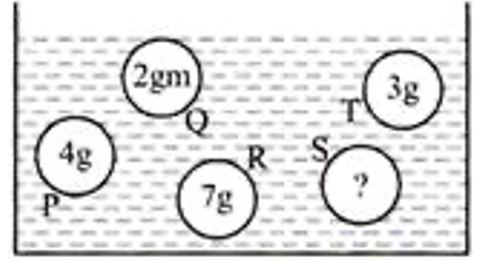
Which of the following could be weight of the 'S?
(A) 8 gm
(B) 6 gm
(C) 1/2 gm
(D) 2.5 gm
Answer:
(B)
Q.3 Rupa transferred the oil of container 'P' to 'Q' as shown below, which of the following undergo change

(A) Volume
(B) Mass
(C) Shape
(D) Temperature
Answer:
(C)
Q.4 Study the flow chart and tell the letters used to show cotton material
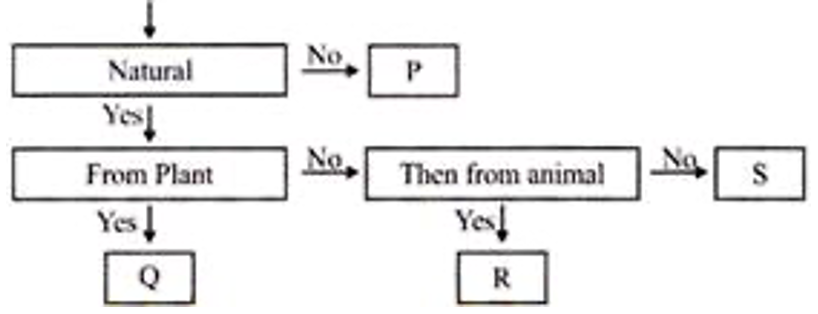
(A) P and Q
(B) Q and R
(C) Q and S
(D)R and S
Answer:
(B)
Q.5 In the given table state of matter, their properties and their examples are represented by letters W, X, Y, Z.
| State of matter | Property | Example |
|---|---|---|
| W | Definite shape | Table |
| Liquid | X | Oil |
| Y | No definite volume and shape | Z |
Oxygen can be placed in the place of letter
(A) X
(B) Y
(C) Z
(D) W
Answer:
(C)
Q.6 Ice-cream melts when energy in the form of .........is supplied
(A) Electricity
(B) Light
(C) Sound
(D) Heat
Answer:
(D)
Q.7 The process by which water change to ice
(A) Melting
(B) Freezing
(C) Evaporation
(D) Condensation
Answer:
(B)
Q.8 Which would be the best material for making the handle of the tea kettle?
(A) Wood
(B) Aluminum
(C) Glass
(D) Iron
Answer:
(A)
Q.9 Plastic has become a commonly utilized material because
(A) Environment friendly
(B) Durable
(C) Light in weight
(D) (B) and (C) both
Answer:
(D)
Q.10 Matter can be defined as something, which has
(A) Weight (mass)
(B) Made up of atoms or molecules
(C) Can exists in three states
(D) All of these
Answer:
(D)
Q.11 Ramesh has P, Q, and R three objects. He puts into a measuring cylinder having 30 ml of water. Then he puts Q and R into the same measuring cylinder. If the given diagram shows thechange in level of water as each was put. Which objects has volume of less than 30 ml?
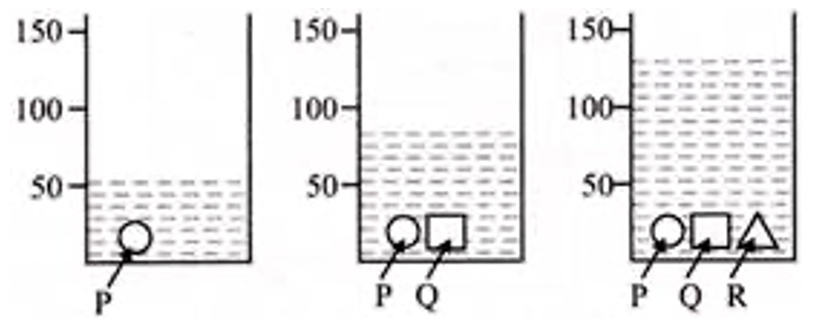
(A) P only
(B) Q only
(C) P and Q both
(D) P, Q and R
Answer:
(C)
Q.12 The intermolecular space between the molecule is maximum in which state
(A) Gas
(B) Liquid
(C) Solid
(D) All of these
Answer:
(A)
Q.13 Rajesh looking through a material which condition represents a translucent material
(A) Able to see clearly through it
(B) Not able to see at all through it
(C) Able to see partially
(D) All of these
Answer:
(C)
Q.14 The forces of attraction between the molecules is strongest in which condition
(A) Solid
(B) Liquid
(C) Gaseous
(D) None of these
Answer:
(A)
Q.15 Select the false statement from the following
(A) Matter exists in three forms
(B) Matter is changeable from one form to another
(C) A new substance is formed by chemical reaction
(D) Ice is heavier that water
Answer:
(D)
Q.16 Two syringes P and Q were filled with two different substances. After closing the outlet plunger where pushed. Syringe P was pushed sometime but Q was not pushed at all. What will be likely substance in P and Q syringe.
(A) Air and water
(B) Oil and water
(C) Oil and air
(D) Water and oil
Answer:
(A)
Q.17 There is a glass jar of 500 ml capacity containing air which is connected to a pump. When the piston of the pump is pushed 100 ml air is pushed in the jar what will be final volume of jar
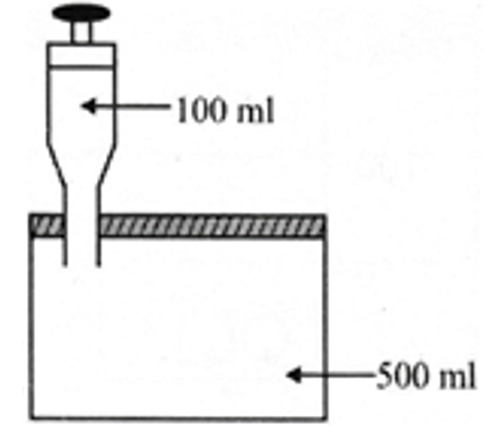
(A) 600 ml
(B) 500 ml
(C) 400 ml
(D) 550 ml
Answer:
(B)
Q.18 Which of the following is not true?
(A) Air is not a matter
(B) Atom is smallest amount
(C) Molecules in solids are closely packed
(D) Matter is made up of atom and molecules
Answer:
(A)
Q.19 Study the given diagram and select the correct one
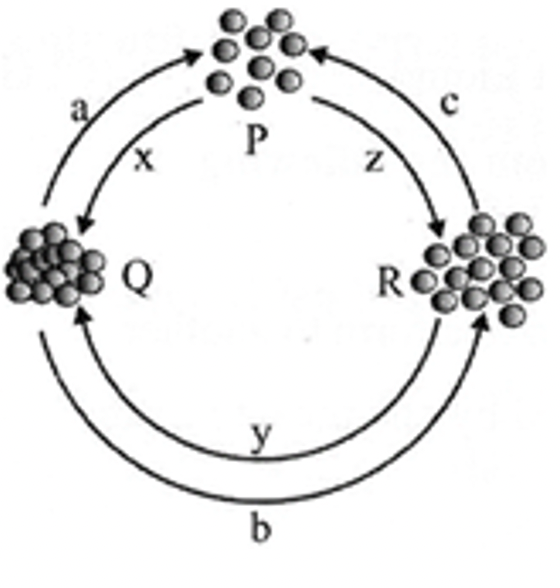
(A) Q - solid, P - gas, Y - freezing
(B) R - solid, P - liquid, Z - Heating
(C) P - liquid, Q - gas, X - freezing
(D) Q - solid, R - gas, Y ? freezing
Answer:
(A)
Q.20 Identify the different material available in beaker
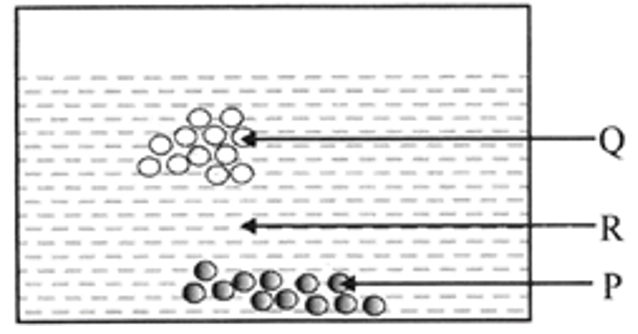
(A) P - liquid, R - gas, Q - solid
(B) P - solid, Q - gas, R ? liquid
(C) P - gas, Q - liquid, R - solid
(D) P - solid, Q - liquid, R - gas
Answer:
(B)
Q.21 A substance which allows light to pass through it, can break when heated also it does not come from plant source could be
(A) Ceramic tile
(B) Rubber band
(C) Glass pan
(D) Iron rod
Answer:
(C)
Q.22 An article is made of two metals X and Y as shown below. It is heated for minutes after that its shape changes as soon in figure. What information can be derived from this?

(A) Metal X expands more than metal Y
(B) Metal Y expands more than X
(C) Metal X contracts and melt Y expands
(D) Metal X expands and Y contracts
Answer:
(A)
Q.23 Oxygen, carbon dioxide and nitrogen can be grouped together, because at room temperature they are all.
(A) Suspension
(B) Colloids
(C) Solid
(D) Gases
Answer:
(D)
Q.24 Which of the followings are present in carbohydrates?
(A) Oxygen
(B) Carbon
(C) Hydrogen
(D) All of these
Answer:
(D)
Q.25 In bar magnet, the molecules are held by
(A) strong force of attraction
(B) weak force of attraction
(C) No force of attraction
(D) Strong force of repulsion
Answer:
(A)
Q.26 Go through the given table and name the solutes which are soluble in water.
| Substance | Solvent | Remarks |
| Sand | Water | Does not dissolve |
| Sugar | Water | Dissolves |
| Salt
|
Water | Dissolves |
| Water | Kerosene | Does not dissolve |
| Oxygen | Water | Dissolve |
(A) Sand and sugar
(B) Sand and salt
(C) Salt and sugar
(D) Salt solution
Answer:
(B)
Q.27 Heat conduction occurs fastest in
(A) Solid
(B) Liquid
(C) Gas
(D) None of these
Answer:
(A)
Q.28 Which of the following determines the state of matter?
(A) Size
(B) Shape
(C) Structure
(D) Arrangement of molecules
Answer:
(D)
Q.29 Which of these process converts liquid to gaseous state?
(A) Condensation
(B) Evaporation
(C) Melting
(D) Freezing
Answer:
(B)
Q.30 Match the following articles and character given
| (a) Clay | (i) Transparent |
| (b) Glass | (ii) Shiny |
| (c) Metal | (iii) Brittle |
(A) a - (iii), b - (ii), c - (i)
(B) a - (ii), b - (iii), (c - (i)
(C) a - (iii), b - (i), c - (ii)
(D) a - (i), b - (ii), (c - (iii)
Answer:
(C)